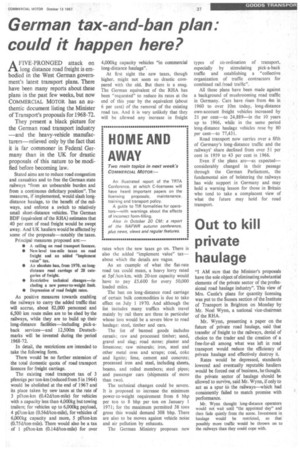German tax-and-ban plan: could it happen here?
Page 39

If you've noticed an error in this article please click here to report it so we can fix it.
AFIVE-PRONGED attack on long distance road freight is embodied in the West German govern ment's latest transport plans. There have been many reports about these plans in the past few weeks, but now COMMERCIAL MOTOR has an authentic document listing the Minister of Transport's proposals for 1968-72.
They present a black picture for the German road transport industry —and the heavy-vehicle manufacturers—relieved only by the fact that it is far commoner in Federal Germany than in the UK for drastic proposals of this nature to be modi fied before becoming law.
Stated aims are to reduce road congestion and casualties and to free the German state railways "from an unbearable burden and from a continuous deficitary position". The measures, if implemented, would slash longdistance haulage, to the benefit of the railways, and enforce a switch to relatively small short-distance vehicles. The German BDF (equivalent of the RHA) estimates that 40 per cent of road freight would be swept away. And UK hauliers would be affected by some of the proposals—notably the taxes.
Principal measures proposed are:—
• A ceiling on road transport licences.
• New-level ton-mile taxes on road freight and an added "implement value" tax.
• An absolute ban, front 1970, on longdistance road carriage of 28 categories of freight.
• Restrictive technical changes—including a new power-to-weight limit.
• Depression of road freight rates.
As positive measures towards enabling the railways to carry the added traffic that will accrue, about 82,000 personnel and 6,500 km route miles are to be shed by the railways, while they are to build up their long-distance facilities—including pick-aback services—and 12,500m Deutschmarks will be invested during the period 1968-72.
In detail, the restrictions are intended to take the following form.
There would be no further extension of the total domestic quota of road transport licences for freight carriage.
The existing road transport tax of 3 pfennigs per ton-km (reduced from 5 in 1964) would be abolished at the end of 1967 and its place taken by new taxes at the rate of 3 pf/ton-km (0.42d/ton-mile) for vehicles with a capacity less than 4,000kg but towing trailers; for vehicles up to 6,000kg payload, 4 pf/ton-km (0.56d/ton-mile), for vehicles of 6,000kg capacity and more, 5 pf/ton-km (0.75d/ton-mile). There would also be a tax of 1 pf/ton-km (0.14d/ton-mile) for over 4,000kg capacity vehicles "in commercial long-distance haulage".
At first sight the new taxes, though higher, might not seem so drastic compared with the old. But there is a snag. The German equivalent of the RHA has been "requested" to reduce its rates at the end of this year by the equivalent (about 6 per cent) of the removal of the existing road tax. And it is very unlikely that they will be allowed any increase in freight
rates when the new taxes go on. There is also the added "implement value" tax— about which the details are vague.
As an example of what the fiat-rate road tax could mean, a heavy lorry rated at 5pf /ton-km. with 20-ton capacity would have to pay £5,600 for every 50,000 loaded miles.
The ban on long-distance road carriage of certain bulk commodities is due to take effect on July 1 1970. And although the list includes many traffics which travel mainly by rail there are three in particular whose loss would be a severe blow to road haulage: steel, timber and cars.
The list of banned goods includes cereals; raw and processed timber; sand, gravel and slag; road stone; plaster and limestone; raw minerals; iron, steel and other metal ores and scraps; coal, coke and lignite; lime, cement and concrete; processed iron and steel, including sheets, beams, and rolled members; steel pipes; and passenger cars (shipments of more than two).
The technical changes could be severe. It is proposed to increase the minimum power-to-weight requirement from 6 bhp per ton to 8 bhp per ton on January 1 1971; for the maximum permitted 38 tons gross this would demand 308 bhp. There • are also to be moves against vehicle noise and air pollution by exhausts. The German Ministry proposes new
types of co-ordination of transport, especially by stimulating pick-a-back traffic and establishing a "collective organization of traffic contractors for combined rail /road traffic".
All these plans have been made against a background of mushrooming road traffic in Germany. Cars have risen from 4m in 1960 to over 10m today, long-distance own-account freight vehicles increased by 21 per cent—to 24,889—in the 10 years up to 1966, while in the same period long-distance haulage vehicles rose by 80 per cent—to 77,431.
Road transport now carries over a fifth of Germany's long-distance traffic and the railways' share declined from over 51 per cent in 1959 to 43 per cent in 1966.
Even if the plans are—as expected— considerably changed in their passage through the German Parliament, the fundamental aim of bolstering the railways has wide support in Germany and may hold a warning lesson for those in Britain who tend to take a complacent view of what the future may hold for road transport.
•


































































































































